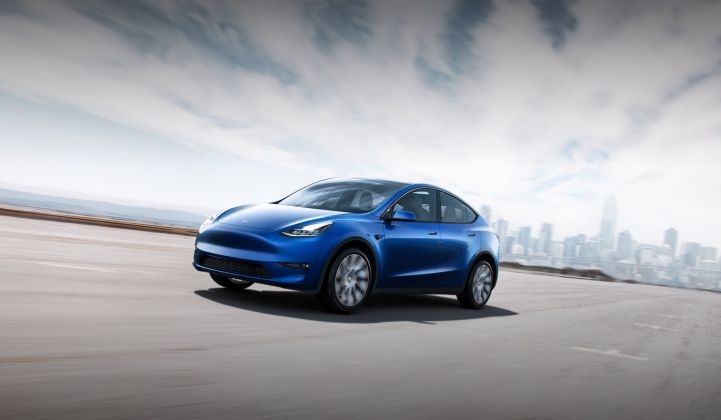Tesla revealed the Model Y small crossover at its Southern California offices late Thursday night. The new product introduction comes at the same time that the EV pioneer is going through a bit of a restructuring.
Tesla has held parties like this in the past, including for the Semi electric truck and the Roadster refresh unveilings in November 2017, and for the solar roof display in October 2016. None of those products are yet in mass production.
However, the Model 3 reveal (and its $35,000 price target) brought in hundreds of thousands of reservations at $1,000 each — essentially an interest-free loan for the capital-hungry EV market leader.
On Thursday, a relaxed and jovial Musk gave an adoring crowd an "extended history lesson" on Tesla's decade-long trajectory.
Musk said that there was a time when making a car company was "stupid" and making an electric car company was "stupid squared." But, he added, "now we’ve made around 550,000 cars," he added.
The CEO proceeded to roll out each of Tesla's vehicles — the Roadster, Model S, Model X and Model 3, as well as the planned Roadster refresh and Semi truck. Musk said that the company got a bit carried away with the Model X, creating something like "a Faberge egg meets a space ship." There was no sign of the Tesla pickup truck.
Musk spoke of the car and battery factories, the pain of manufacturing and described the 20,000 people at the Fremont plant as a "giant cybernetic collective." Musk showed a rendering of the Chinese factory with a completed shell targeted for the end of the year. He cited the company's 12,000 chargers at 1,400 stations and proclaimed that it is great to see other automakers going electric.
Musk also said, "This is the year of the solar roof and Powerwall." Batteries were at a premium in 2018 "because all resources had to reallocated to Model 3 production — otherwise we were going to die," said the CEO.
"But now that Model 3 production is going well, we're excited about the solar roof, solar retrofit and Powerwall," he said.
"A future you can be excited about"
Solar installations have plunged at Tesla. According to data from Wood Mackenzie Power & Renewables, Tesla’s residential solar installation market share has dropped from 33.5 percent a few years ago to 9.1 percent, allowing Sunrun to clinch the title of market leader.
Tesla deployed 73 megawatts of PV in the last quarter of 2018 compared to the 272 megawatts SolarCity installed in the last quarter of 2015. And Tesla’s guidance for solar deployments for this quarter is down.
As for the solar roof, back in October 2016, Musk unveiled the product on the set of a TV show. Now, two-and-a-half years later, and after having received deposits from interested homeowners, Tesla has connected just a dozen or so solar-integrated roofs to the grid.
But even amid supply constraints, Tesla has potentially won a contract from California utility PG&E for a massive 182.5-megawatt/730-megawatt-hour battery that will replace gas peakers and save ratepayers money. The current record-holder for the world's biggest battery is Tesla’s 100-megawatt system in Australia.
Musk maintains, "Solar plus battery plus electric vehicles is a sustainable future you can be excited about."
Finally, the Model Y
After that long windup, a blue Model Y rolled onto the stage in a bit of an anticlimax — it was difficult to distinguish the Model Y crossover from the Model 3 sedan, at least online.
Musk said the Model Y had the "functionality of an SUV but the ride of a sports car." He said it would do 0 to 60 mph in 3.5 seconds with an actual true usable range of 300 miles.
Higher-end versions of the crossover will be available in fall 2020 at a price of $47,000 to $51,000. Musk did not reveal where the Model Y would be built, how it would be financed, and who in the company's reduced workforce will build it. The company is accepting $2,500 deposits.
Musk also suggested that driving a Model Y on Mars in 10 years was not out of the question.




